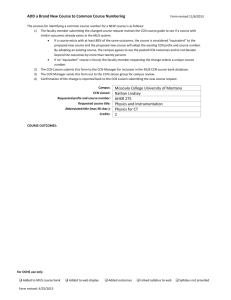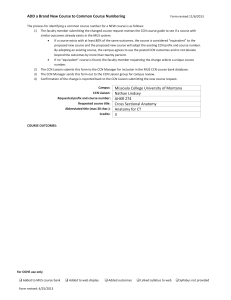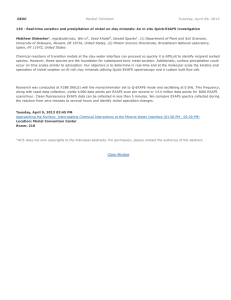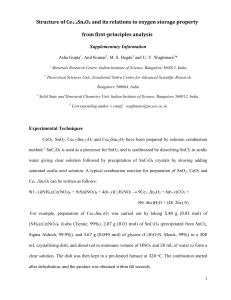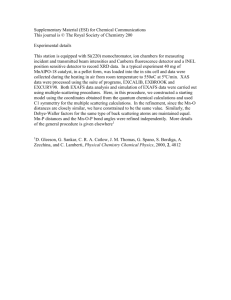Local structure of Pt and Pd ions in Ce Ti O
advertisement
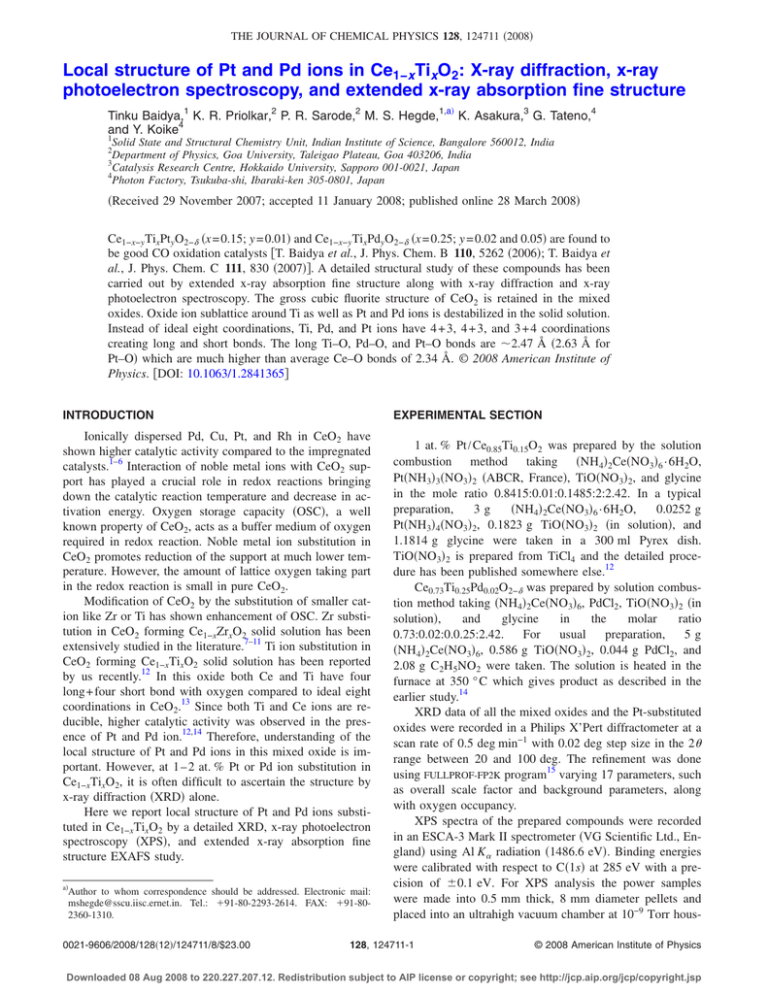
THE JOURNAL OF CHEMICAL PHYSICS 128, 124711 共2008兲 Local structure of Pt and Pd ions in Ce1−xTixO2: X-ray diffraction, x-ray photoelectron spectroscopy, and extended x-ray absorption fine structure Tinku Baidya,1 K. R. Priolkar,2 P. R. Sarode,2 M. S. Hegde,1,a兲 K. Asakura,3 G. Tateno,4 and Y. Koike4 1 Solid State and Structural Chemistry Unit, Indian Institute of Science, Bangalore 560012, India Department of Physics, Goa University, Taleigao Plateau, Goa 403206, India 3 Catalysis Research Centre, Hokkaido University, Sapporo 001-0021, Japan 4 Photon Factory, Tsukuba-shi, Ibaraki-ken 305-0801, Japan 2 共Received 29 November 2007; accepted 11 January 2008; published online 28 March 2008兲 Ce1−x−yTixPtyO2−␦ 共x = 0.15; y = 0.01兲 and Ce1−x−yTixPdyO2−␦ 共x = 0.25; y = 0.02 and 0.05兲 are found to be good CO oxidation catalysts 关T. Baidya et al., J. Phys. Chem. B 110, 5262 共2006兲; T. Baidya et al., J. Phys. Chem. C 111, 830 共2007兲兴. A detailed structural study of these compounds has been carried out by extended x-ray absorption fine structure along with x-ray diffraction and x-ray photoelectron spectroscopy. The gross cubic fluorite structure of CeO2 is retained in the mixed oxides. Oxide ion sublattice around Ti as well as Pt and Pd ions is destabilized in the solid solution. Instead of ideal eight coordinations, Ti, Pd, and Pt ions have 4 + 3, 4 + 3, and 3 + 4 coordinations creating long and short bonds. The long Ti–O, Pd–O, and Pt–O bonds are ⬃2.47 Å 共2.63 Å for Pt–O兲 which are much higher than average Ce–O bonds of 2.34 Å. © 2008 American Institute of Physics. 关DOI: 10.1063/1.2841365兴 INTRODUCTION EXPERIMENTAL SECTION Ionically dispersed Pd, Cu, Pt, and Rh in CeO2 have shown higher catalytic activity compared to the impregnated catalysts.1–6 Interaction of noble metal ions with CeO2 support has played a crucial role in redox reactions bringing down the catalytic reaction temperature and decrease in activation energy. Oxygen storage capacity 共OSC兲, a well known property of CeO2, acts as a buffer medium of oxygen required in redox reaction. Noble metal ion substitution in CeO2 promotes reduction of the support at much lower temperature. However, the amount of lattice oxygen taking part in the redox reaction is small in pure CeO2. Modification of CeO2 by the substitution of smaller cation like Zr or Ti has shown enhancement of OSC. Zr substitution in CeO2 forming Ce1−xZrxO2 solid solution has been extensively studied in the literature.7–11 Ti ion substitution in CeO2 forming Ce1−xTixO2 solid solution has been reported by us recently.12 In this oxide both Ce and Ti have four long+ four short bond with oxygen compared to ideal eight coordinations in CeO2.13 Since both Ti and Ce ions are reducible, higher catalytic activity was observed in the presence of Pt and Pd ion.12,14 Therefore, understanding of the local structure of Pt and Pd ions in this mixed oxide is important. However, at 1 – 2 at. % Pt or Pd ion substitution in Ce1−xTixO2, it is often difficult to ascertain the structure by x-ray diffraction 共XRD兲 alone. Here we report local structure of Pt and Pd ions substituted in Ce1−xTixO2 by a detailed XRD, x-ray photoelectron spectroscopy 共XPS兲, and extended x-ray absorption fine structure EXAFS study. a兲 Author to whom correspondence should be addressed. Electronic mail: mshegde@sscu.iisc.ernet.in. Tel.: ⫹91-80-2293-2614. FAX: ⫹91-802360-1310. 0021-9606/2008/128共12兲/124711/8/$23.00 1 at. % Pt/ Ce0.85Ti0.15O2 was prepared by the solution combustion method taking 共NH4兲2Ce共NO3兲6 · 6H2O, Pt共NH3兲3共NO3兲2 共ABCR, France兲, TiO共NO3兲2, and glycine in the mole ratio 0.8415:0.01:0.1485:2:2.42. In a typical 0.0252 g preparation, 3g 共NH4兲2Ce共NO3兲6 · 6H2O, Pt共NH3兲4共NO3兲2, 0.1823 g TiO共NO3兲2 共in solution兲, and 1.1814 g glycine were taken in a 300 ml Pyrex dish. TiO共NO3兲2 is prepared from TiCl4 and the detailed procedure has been published somewhere else.12 Ce0.73Ti0.25Pd0.02O2−␦ was prepared by solution combustion method taking 共NH4兲2Ce共NO3兲6, PdCl2, TiO共NO3兲2 共in solution兲, and glycine in the molar ratio 0.73:0.02:0.0.25:2.42. For usual preparation, 5g 共NH4兲2Ce共NO3兲6, 0.586 g TiO共NO3兲2, 0.044 g PdCl2, and 2.08 g C2H5NO2 were taken. The solution is heated in the furnace at 350 ° C which gives product as described in the earlier study.14 XRD data of all the mixed oxides and the Pt-substituted oxides were recorded in a Philips X’Pert diffractometer at a scan rate of 0.5 deg min−1 with 0.02 deg step size in the 2 range between 20 and 100 deg. The refinement was done using FULLPROF-FP2K program15 varying 17 parameters, such as overall scale factor and background parameters, along with oxygen occupancy. XPS spectra of the prepared compounds were recorded in an ESCA-3 Mark II spectrometer 共VG Scientific Ltd., England兲 using Al K␣ radiation 共1486.6 eV兲. Binding energies were calibrated with respect to C共1s兲 at 285 eV with a precision of ⫾0.1 eV. For XPS analysis the power samples were made into 0.5 mm thick, 8 mm diameter pellets and placed into an ultrahigh vacuum chamber at 10−9 Torr hous- 128, 124711-1 © 2008 American Institute of Physics Downloaded 08 Aug 2008 to 220.227.207.12. Redistribution subject to AIP license or copyright; see http://jcp.aip.org/jcp/copyright.jsp 124711-2 Baidya et al. J. Chem. Phys. 128, 124711 共2008兲 ing the analyzer. The obtained spectra were curve fitted with Gaussian peaks after subtracting a linear background. Ti K, Pt LIII, and Pd K edge EXAFS spectra in catalyst and reference samples were recorded at room temperature in the transmission mode with Si共311兲 and Si共111兲 doublecrystal monochromators at NW10A and BL9A beamlines, respectively, at Photon Factory, Japan.16,17 EXAFS was scanned from 4.7 to 5.6 keV, from 11 to 12 keV for Pt EXAFS, and from 24.2 to 25.6 keV for Pd EXAFS spectra. The photon energy was calibrated for each scan with the first inflection point of the absorption edge in respective metal foil. Both the incident 共I0兲 and transmitted 共I兲 synchrotron beam intensities were measured simultaneously using ionization chamber filled with appropriate gases. The absorbers were made by pressing the fine powder samples into pellets of 10 mm diameter with boron nitride. To avoid the sample thickness effect, the total x was restricted to a value 艋3 by adjusting the thickness of the absorber pellet where is the absorption coefficient and x is the sample thickness.18 EXAFS data analysis was done using IFEFFIT program. The value of amplitude reduction factor 共S02兲 is deduced from the EXAFS spectra of respective metals with known crystal structural data.19 The theoretical calculation of backscattering amplitude and phase shift functions is obtained by using FEFT 共6.01兲 program.20 The experimental EXAFS data were fitted with the theoretical EXAFS function using FEFFIT program.21 RESULTS AND DISCUSSION XRD study XRD was carried out to see whether platinum ions are substituted into the Ce0.85Ti0.15O2 matrix in Pt/ Ce0.85Ti0.15O2 catalyst. Figure 1共a兲 shows the XRD pattern of as-prepared 1 at. % Pt/ Ce0.85Ti0.15O2 and 1 at. % Pt impregnated over Ce0.85Ti0.15O2 with ten times enlarged in the Y scale. The pattern can be indexed to the fluorite structure. Observed, calculated, and difference XRD patterns of 1 at. % Pt/ Ce0.85Ti0.15O2 are shown in Fig. 1共b兲. The RBragg, R factor, and 2 values are 1.75, 1.81, and 1.04, respectively. Keeping all the parameters the same and Pt ion occupancy equal to 0.0, RBragg, RF, and 2 were 2.25, 1.64, and 1.15, respectively. The increase in R factors is significant. This test confirms Pt ion substitution for Ti/ Ce sites in the lattice. Therefore, the present model which considers Pt ion substitution at Ce4+ site in Ce1−xTixO2 lattice is possible. The lattice parameter of Ce0.85Ti0.15O2 is 5.4032共2兲 Å and in the 1 at. % Pt ion substituted Ce0.85Ti0.15O2, lattice parameter changes to 5.4052共3兲 Å. There are no impurity peaks due to the presence of platinum metal or oxides. This is further confirmed by recording 1 at. % Pt impregnated over Ce0.85Ti0.15O2 where intense Pt共111兲 peak is observed. In the impregnated compound Pt共111兲 peak is clearly observed, as indicated in Fig. 1共a兲. 1% Pt-substituted catalyst was reduced in 5 % H2 / Ar gas at 300 ° C for 1 h. Color changed from gray to black. Figure 2 shows the XRD pattern of the reduced sample with magnification in the Y scale. Pt共111兲 peak at 2 = 39.8 is not observed. This shows that short duration reduction does not FIG. 1. 共a兲 Ten times enlarged XRD pattern of 1 at. % Pt/ Ce0.85Ti0.15O2 and 1 at. % Pt/ Ce0.85Ti0.15O2 共impregnated兲 and 共b兲 Rietveld refined 1 at. % Pt/ Ce0.85Ti0.15O2. allow Pt metal atoms sintering to metal particles. We believe that atoms are retained in the same sites as in the unreduced samples. A similar experiment has been reported in the literature as an evidence for Pd ion substitution in perovskite lattice.22–24 However, reduction of Pt ion in H2 and easy reoxidation in O2 have been shown by XPS study earlier.12 FIG. 2. XRD pattern of 1 at. % Pt/ Ce0.85Ti0.15O2 共at 300 ° C兲, 2 at. % Pd/ Ce0.75Ti0.25O2 共at 500 ° C兲, and 2% PdO + Ce0.75Ti0.25O2 共at 500 ° C兲 reduced in 5% H2 + 95% Ar gas. Downloaded 08 Aug 2008 to 220.227.207.12. Redistribution subject to AIP license or copyright; see http://jcp.aip.org/jcp/copyright.jsp 124711-3 Local structure of Pt and Pd ions in Ce1−xTixO2: XRD, XPS, and EXAFS study FIG. 3. 共a兲 Ten times enlarged XRD pattern of 2 and 共b兲 5 at. % Pd/ Ce0.75Ti0.25O2. Figure 3共a兲 shows the XRD pattern of as-prepared 2 and 5 at. % Pd/ Ce0.75Ti0.25O2 which is ten times enlarged in the Y scale. The patterns show fluorite phase of the catalysts. No intensity peak due to Pd metal particle or PdO can be observed. Figure 3共b兲 shows the Rietveld refined XRD profile of 5 at. % Pd/ Ce0.75Ti0.25O2. RBragg, R factor, and 2 values are 1.94, 2.90, and 1.44 for 2 at. % Pd/ Ce0.75Ti0.25O2 and 3.57, 2.36, and 1.29 for 5 at. % Pd/ Ce0.75Ti0.25O2, respectively. Lattice parameter values are, respectively, 5.3992共6兲 and 5.4082共5兲 Å. The increase in lattice parameter is 5% Pd substituted compound due to higher ionic radii of Pd2+ ion compared to smaller Ti4+ ion which gets substituted by Pd2+ ion. Similar to Pt- substituted catalyst, in Fig. 2 the XRD pattern of Ce0.73Ti0.25Pd0.02O2−␦ and 2 at. % PdO + Ce0.75Ti0.25O2 共mixture兲 reduced in H2 is shown. Pd共111兲 metal peak at 2 = 40.2 is not observed in the substituted catalyst whereas the same gives a prominent peak in 2 at. % PdO + Ce0.75Ti0.25O2. J. Chem. Phys. 128, 124711 共2008兲 FIG. 4. Pt共4f兲 core level spectra in 共a兲 Pt metal foil and 共b兲 1 at. % Pt/ Ce0.85Ti0.15O2. particles shows 4f 7/2,5/2 at 71.1 and 74.3 eV, respectively 关Fig. 4共a兲兴. However, Pt spectra are very broad in the oxide support. Therefore, Pt共4f兲 spectrum was deconvoluted into sets of spin-orbit doublets for different oxidation states of Pt. In 1% Pt/ Ce0.85Ti0.15O2, the Pt共4f兲 region 关Fig. 4共b兲兴 was deconvoluted into two sets of spin-orbit doublets because significant intensity due to metallic platinum was not observed even after ten times magnification in XRD. Accordingly, the peaks at 72.8, 76 and 75, 78.2 eV are attributed to XPS study The valence state of platinum species in the Ce1−xTixO2 support was determined by XPS of Pt共4f兲 core level spectra. Pt共4f兲 core level region in pt metal foil and as-prepared 1 at. % Pt/ Ce0.85Ti0.15O2 is given in Fig. 4. Pt0 in Pt metal FIG. 5. Ti共2p兲 core level spectra in 共a兲 TiO2 and 共b兲 1 at. % Pt/ Ce0.85Ti0.15O2. Downloaded 08 Aug 2008 to 220.227.207.12. Redistribution subject to AIP license or copyright; see http://jcp.aip.org/jcp/copyright.jsp 124711-4 J. Chem. Phys. 128, 124711 共2008兲 Baidya et al. FIG. 7. 共a兲 Fourier transformed EXAFS spectra at the Ti K edge in 1 at. % Pt/ Ce0.85Ti0.15O2 and 共b兲 magnitude of k2 weighted EXAFS spectra in 1 and 2 at. % Pt/ Ce0.85Ti0.15O2. FIG. 6. Pd共3d兲 core level spectra in PdO, 2 at. % Pd/ Ce0.75Ti0.25O2, and 5 at. % Pd/ Ce0.75Ti0.25O2. Pt in +2 and +4 oxidation states, respectively. About ⬃65% Pt are in +2 state and the rest is in +4 state in 1 at. % Pt/ Pt0.85Ti0.15O2−␦. The Ti共2p兲 spectrum of pure TiO2 and as-prepared 1 at. % Pt/ Ce0.85Ti0.15O2 is shown in Fig. 5. Binding energies of Ti共2p3/2,1/2兲 at 459.0 and 464.8 eV in TiO2 correspond to Ti in 4+ state 关Fig. 5共a兲兴. The Ti共2p3/2,1/2兲 peaks in as-prepared 1 at. % Pt/ Ce0.85Ti0.15O2 are observed at 458.8 and 464.7 eV 关Fig. 5共b兲兴 and therefore, Ti is essentially in 4+ state in the Pt-substituted catalysts. Similarly, Ce is also present in the 4+ state in all the compounds. Figure 6 shows the Pd共3d兲 core level spectra in PdO, as-prepared 2 and 5 at. % Pd/ Ce0.75Ti0.25O2. The binding energy of Pd共3d5/2兲 in PdO is 336.4 eV corresponding to 2 + state. Pd共3d5/2兲 is observed at 337.7 eV in as-prepared 2 and 5 at. % Pd/ Ce0.75Ti0.25O2. PdCl2 is observed at 338.0 eV.25 Therefore, Pd ion is in +2 state, but it is more ionic in Ce0.75Ti0.25O2 than in PdO. Similarly, both Ti and Ce ions showing similar spectra are found to be in 4+ state. EXAFS study The k2 weighted Fourier transform 共FT兲 of Ti K-edge EXAFS in 1% Pt/ Ce0.85Ti0.15O2 is presented in Fig. 7共a兲. These spectra are very similar to those of Ti EXAFS in Ce1−xTixO2 solid solutions13 where we had reported that the oxygen coordination around Ti is distorted in these solid solutions. From experimental data analysis as well as first prin- TABLE I. EXAFS analysis in Pt/ CeTiO2 at Ti K edge and Pt LIII edge. Sample 1% Pt/ Ce0.85Ti0.15O2 Coordination shell Ti–O Ti–Ti Ti–Ce 1% Pt/ Ce0.85Ti0.15O2 Pt–O Pt–Pt Pt–Ti Pt–Ce R 2 Ti K edge 4 4 1.8 10.2 1.897⫾ 0.06 2.50⫾ 0.02 2.98⫾ 0.03 3.52⫾ 0.06 0.005⫾ 0.001 0.023⫾ 0.006 0.010⫾ 0.004 0.03⫾ 0.01 Pt LIII edge 2.9⫾ 0.1 3.9⫾ 0.1 3.6⫾ 0.6 1.1⫾ 0.3 5.1⫾ 0.7 0.004⫾ 0.003 2.63⫾ 0.04 2.768⫾ 0.002 3.12⫾ 0.02 3.54⫾ 0.01 0.0049⫾ 0.0004 0.041⫾ 0.009 0.0049⫾ 0.0002 0.016⫾ 0.003 0.020⫾ 0.002 CN PT Pt–Pt 12.0 6.0 48.0 24.0 2.762⫾ 0.004 3.901⫾ 0.005 4.138⫾ 0.005 4.778⫾ 0.006 0.009⫾ 0.001 0.013⫾ 0.003 0.016⫾ 0.003 0.015⫾ 0.002 PtO2 Pt–O Pt–Pt Pt–Pt Pt–O 5.6⫾ 0.2 3.7⫾ 0.2 7.6⫾ 0.4 4.5⫾ 0.6 1.989⫾ 0.004 3.153⫾ 0.002 3.556⫾ 0.006 3.695⫾ 0.006 0.002⫾ 0.001 0.006⫾ 0.001 0.014⫾ 0.008 0.005⫾ 0.002 Downloaded 08 Aug 2008 to 220.227.207.12. Redistribution subject to AIP license or copyright; see http://jcp.aip.org/jcp/copyright.jsp 124711-5 Local structure of Pt and Pd ions in Ce1−xTixO2: XRD, XPS, and EXAFS study J. Chem. Phys. 128, 124711 共2008兲 FIG. 8. 共a兲 Magnitude of FT and corresponding backtransforms of Pt LIII edge in Pt metal foil and PtO2 and 共b兲 backtransformed k3 weighted EXAFS with fit and magnitude of FT of Pt LIII edge in 1 at. % Pt/ Ce0.85Ti0.15O2. cipal theoretical calculations it was found that of the eight O’s surrounding the metal ion in fluorite structure, four come closer and four move away. The weighted EXAFS data in the k range 2 – 10 Å−1 were transformed to R space and was fitted to the same 4 + 4 coordination model using Ti–O correlations and Ti–Ti and Ti–Ce coordination shells. The re- sultant backtransformed data along with the fit are presented in Fig. 7共b兲. The values of bond lengths and Debye–Waller terms are presented in Table I. When coordination was taken as 8, 6 + 2 or 4 + 2 + 2 fitting was poor. Figure 8共a兲 shows the k3 weighted FT of the Pt LIII EXAFS spectra of Pt metal and PtO2 along with their inverse Downloaded 08 Aug 2008 to 220.227.207.12. Redistribution subject to AIP license or copyright; see http://jcp.aip.org/jcp/copyright.jsp 124711-6 Baidya et al. FIG. 9. 共a兲 Fourier transformed EXAFS spectra at the Ti K edge in 2 and 5 at. % Pd/ Ce0.75Ti0.25O2 and 共b兲 magnitude of k2 weighted EXAFS spectra in 1 and 2 at. % Pt/ Ce0.85Ti0.15O2. transforms. The Fourier transforms are not corrected for phase shift and hence the peaks are shifted to lower R values. However, as mentioned above, the values of bond distance quoted in the text and table are corrected for phase shift. For Pt metal foil, the Pt–Pt scattering peak is seen at 2.76 Å. In addition to it, a small peak on the lower R side of the main peak can be seen. This is caused by both the k-dependent behavior of backscattering amplitude and nonlinearly in the phase shift function. Pt–O correlation in PtO2 appears at about 1.99 Å and a Pt–Pt correlation is observed at an average distance of 3.15 Å. The values of bond distance, coordination number, and Debye–Waller factors obtained from fitting the EXAFS data in the R range 1 – 4 Å are presented in Table I. These values agree well with the structural data of Pt and PtO2. In the case of 1% Pt/ Ce0.85Ti0.15O2 关Fig. 8共b兲兴, a strong peak at about 1.5 Å 共phase shift uncorrected兲 is observed which is absent in Pt metal. This correlation is attributed to the Pt–O bond at 2.0 Å. Further a broad structure with at least three distinct maxima is seen in the range 2 – 4 Å. This broad structure distinctly consists of at least three correlations and it is similar to that observed in 1% Pt/ CeO2.26 But there are important differences in the two spectra particularly in weighting of the doublet structure, positions of the maxima as well as in the strength of the first Pt–O correlation at 2 Å. therefore, in Pt/ CeTiO2 catalyst although Pt could be J. Chem. Phys. 128, 124711 共2008兲 in similar environment as that in Pt/ CeO2 the nature of correlations could be different. This could be due to distorted ceria-titania matrix that Pt finds itself in Pt/ CeTiO2. Therefore, to fit the EXAFS data, a model wherein Pt ion is substituted for Ce/ Ti ion in Pt/ Ce0.8Ti0.2O2 structure forming a solid solution of the type Pt0.01Ce0.79Ti0.2O2−␦ was considered. This model gave a good fit and the fitted parameters obtained are listed in Table I. In the solid solution phase, Pt has ⬃3 + 4 oxygen coordination at 2.0 and 2.63 Å in the catalyst. If Pt ions are substituted for Ce4+ sites, the first coordination around Pt ion will be of oxide ions. In the case of Ce1−xTixO2, Ce has distorted oxygen coordination around it with four oxygen ions coming closer and four moving away. Accordingly, the coordination of ⬃7 共4 short+ 3 long兲 for the Pt–O bond in the catalyst can be understood to be due to substitution of Pt2+ ions for Ce4+ ions just as Ti4+ ion in CeO2 accounting for overall oxide ion vacancy. Since 65% of Pt ions is in lower oxidation state, oxide ion vacancy is expected and the observed lower coordination supports this. Further, Pt–Pt, Pt–Ti, and Pt–Ce correlation were obtained at 2.76, 3.12, and 3.53 Å, respectively. These correlations indicate the presence of Pt ion in fluorite lattice. The total coordination number obtained was about 10 which is close to that expected for Pt substitution for Ce ion in 共CeTi兲O2 solid solution having fluorite structure. The Pt–Ce bond distance of 3.53 Å is also close to Ti–Ce distance 共3.5 Å兲 obtained in 共CeTi兲O2 solid solutions. However, the Pt–Pt coordination number 共⬃4兲 is quite large. It must be mentioned here that while fitting, the coordination numbers were essentially kept fixed to their respective concentration ratio. In the case of Pt–Pt, Pt–Ti, and Pt–Ce, a good fit was obtained only for a combination of 4, 1, and 5, respectively. The k2 weighted FT of Ti K-edge EXAFS in 2 and 5 at. % Pd/ Ce0.75Ti0.25O2 is presented in Fig. 9共a兲. This spectrum is similar to those of Ti EXAFS in Ce1−xTixO2 solid solutions.13 The weighted EXAFS data in the k range 2 – 10 Å−1 were transformed to R space and were fitted to the same 4 + 4 model using Ti–O correlations and Ti–Ti and Ti–Ce coordination shells. The resultant backtransformed data along with the fit are presented in Fig. 9共b兲. The values of bond lengths and Debye–Waller terms are presented in Table II. The second shell in the Ti–O coordination sphere is ⬃3. This is due to creation of oxide ion vacancy for lower valent Pd2+ ion substitution. Figures 10共a兲 and 10共b兲 show background subtracted k3-weighted Pd K EXAFS function with fit and its magnitude in Pd metal and PdO. The EXAFS spectrum of the catalyst is similar to that of PdO, indicating Pd to be in +2 state. The phase corrected values of EXAFS data are given in Table II. The FT of PdO shows three distinct peaks in the range 1 – 3.5 Å. It is known from the crystal structure data that in PdO, Pd ion is surrounded by four O ions at 2.02 Å and Pd ions at 2.67 and 3.08 Å with coordination numbers 2 and 4, respectively. These shells contribute to the first two peaks while the third peak has contributions from 8 neighbored Pd–O shell at 3.58 Å and 16 neighbored Pd–Pd shell at 3.72 Å. From the EXAFS data, we have shown local structure of Ce4+, Ti4+, and Pd2+ ions in Fig. 11. Ce4+ is found to have four Ce–O bonds of 2.30 Å and four Ce–O of 2.42 Å.13 Downloaded 08 Aug 2008 to 220.227.207.12. Redistribution subject to AIP license or copyright; see http://jcp.aip.org/jcp/copyright.jsp 124711-7 Local structure of Pt and Pd ions in Ce1−xTixO2: XRD, XPS, and EXAFS study J. Chem. Phys. 128, 124711 共2008兲 TABLE II. EXAFS analysis in Pd metal, PdO, and Pd/ CeTiO2 at Ti K and Pd K edges. Sample 2% Pd/ Ce0.75Ti0.25O2 Coordination shell Ti–O Ti–Ti Ti–Ce 5% Pd/ Ce0.75Ti0.25O2 R 2 Ti K edge 4 2.9⫾ 0.5 2.2⫾ 0.6 9.0⫾ 0.2 1.925⫾ 0.004 2.48⫾ 0.02 3.05⫾ 0.03 3.67⫾ 0.03 0.007⫾ 0.001 0.032⫾ 0.006 0.019⫾ 0.005 0.038⫾ 0.006 4 3.0⫾ 0.4 2.0⫾ 0.7 5.3⫾ 0.2 1.2⫾ 0.4 1.903⫾ 0.004 2.42⫾ 0.01 3.15⫾ 0.05 3.82⫾ 0.08 3.20⫾ 0.03 0.0064⫾ 0.0007 0.022⫾ 0.004 0.025⫾ 0.009 0.062⫾ 0.01 0.010⫾ 0.001 Pd K edge 4.0⫾ 0.02 3.2⫾ 0.6 1.8⫾ 0.1 2.8⫾ 0.4 6.3⫾ 0.4 2.007⫾ 0.004 2.47⫾ 0.02 3.059⫾ 0.005 2.89⫾ 0.01 3.330⫾ 0.004 0.0028⫾ 0.0004 0.013⫾ 0.003 0.0048⫾ 0.0005 0.014⫾ 0.002 0.0097⫾ 0.0004 CN Ti–O Ti–Ti Ti–Ce Ti–Pd 2% Pd/ Ce0.75Ti0.25O2 Pd–O Pd–Pd Pd–Ti Pd–Ce Pd PdO Pd–Pd 12.0 6.0 48.0 24.0 2.747⫾ 0.003 3.885⫾ 0.002 4.120⫾ 0.002 4.689⫾ 0.004 0.006⫾ 0.001 0.009⫾ 0.001 0.008⫾ 0.001 0.050⫾ 0.004 Pd–O Pd–Pd Pd–Pd Pd–O Pd–O/Pd 4.0 2.0 4.0 8.0 16.0 2.023⫾ 0.005 2.694⫾ 0.008 3.079⫾ 0.009 3.581⫾ 0.002 3.721⫾ 0.009 0.002⫾ 0.001 0.011⫾ 0.003 0.005⫾ 0.001 0.002⫾ 0.001 0.006⫾ 0.001 Both Ti4+ and Pd2+ ions have 4 + 3 coordination. Ti–O bond distances were 1.90 and 2.48 and Pd–O bonds were 2.0 and 2.47 Å. Oxide ion vacancy is obtained in the longer coordination sphere. In the case of catalyst sample, a strong peak at about 1.5 Å 共phase shift uncorrected兲 is seen and can be attributed to Pd–O correlation with a bond length of 2.02 Å. The coordination number obtained from fitting this peak is about 4. The fit, however, is not very good especially in the higher R region where a small correlation, especially in the sample containing 5% Pd, can be seen. Further there is a broad structure extending from little over 2 to about 3.5 Å. This structure is different from the twin peak structure seen in PdO both in terms of peak position and relative heights, indicating the local structure around the metal ion to be different in catalyst from that in PdO. Therefore, the EXAFS was fitted to a model wherein Pd substitutes Ce ion in distorted fluorite FIG. 10. Backtransform EXAFS with fit and magnitude of FT of Pd K edge in Pd and PdO. FIG. 11. Ball and stick model obtained from EXAFS fitting for the first coordination shell around Ce, Ti, and Pd ions in Ce0.73Ti0.25Pd0.02O2−␦. Downloaded 08 Aug 2008 to 220.227.207.12. Redistribution subject to AIP license or copyright; see http://jcp.aip.org/jcp/copyright.jsp 124711-8 J. Chem. Phys. 128, 124711 共2008兲 Baidya et al. ACKNOWLEDGMENTS The authors from IISc and Goa University gratefully acknowledge financial support from the Department of Science and Technology, Government of India. K.R.P. and P.R.S. thank Grant-in-Aid for Scientific Research Category S. No. 16106010 for financial support to carry out EXAFS experiments and PF Advisory Committee 共PAC兲 Approval for approval of the project. P.R.S. would like to thank Hokkaido University for a Visiting Professorship. 1 FIG. 12. Backtransform EXAFS with fit and magnitude of FT of Pd K edge in Ce0.73Ti0.25Pd0.02O2−␦. structure.2 The fitting parameters obtained are presented in Table II and the fitted curves in the backtransformed k space along with those of Pd metal and PdO are presented in Fig. 12. It can be seen that the first peak in the magnitude of FT of EXAFS spectra can be fitted with two Pd–O correlations at 2.02 and 2.47 Å, respectively. The total coordination number is about 7 which can be expected due to substitution of lower valent Pd2+ ion in place of Ce4+ ion. Further, the twin peak structure can be fitted with three correlations, Pd–Ti, Pd–Pd, and Pd–Ce at 2.89, 3.06, and 3.3 Å, respectively. The obtained coordination numbers are also in accordance with atomic concentration of each of these ions as well as the total coordination number is close to 12, which is expected for second coordination in fluorite structure. This clearly confirms that in 2% Pd/CeTiO2 Pd2+ ion substitutes Ce4+ in a distorted fluorite structure. CONCLUSIONS Pt is present in the +2 and +4 ionic state in Ce1−xTixO2, whereas Pd in +2 state. Coordination number as well as Pt–O and Pt–Pt or Pt– Ce/ Ti distances in Pt/ Ce0.85Ti0.15O2 are different from those distances in Pt metal or PtO2. Similarly, Pd substitution gives different bond distances in Ce0.75Ti0.25O2. 1 at. % Pt/ Ce0.85Ti0.15O2 can be written as Ce0.84Ti0.15Pt0.01O2−␦ with cubic fluorite structure. Similarly, 2 and 5 at. % Pt/ Ce0.75Ti0.25O2 can be written as Ce0.73Ti0.25Pd0.02O2−␦ and Ce0.7Ti0.25Pt0.05O2−␦, respectively. P. Bera, K. C. Patil, V. Jayaram, G. N. Subbanna, and M. S. Hegde, J. Catal. 196, 293 共2000兲. 2 K. R. Priolkar, P. Bera, P. R. Sarode, M. S. Hegde, S. Emura, R. Kumashiro, and N. P. Lalla, Chem. Mater. 14, 2120 共2002兲. 3 P. Bera, K. R. Priolkar, P. R. Sarode, M. S. Hegde, S. Emura, R. Kumashiro, V. Jayaram, and N. P. Lalla, Chem. Mater. 14, 3591 共2002兲. 4 P. Bera, K. R. Priolkar, A. Gayen, P. R. Sarode, M. S. Hegde, S. Emura, R. Kumashiro, V. Jayaram, and G. N. Subbanna, Chem. Mater. 15, 2049 共2003兲. 5 A. Gayen, K. R. Priolkar, P. R. Sarode, V. Jayaram, M. S. Hedge, G. N. Subbanna, and S. Emura, Chem. Mater. 16, 2317 共2004兲. 6 P. Bera, A. Gayen, M. S. Hegde, N. Lalla, L. Spadaro, F. Frusteri, and F. Arena, J. Phys. Chem. B 107, 6122 共2003兲. 7 Catalysis by Ceria and Related Materials, edited by A. Trovarelli 共Imperial College Press, London, 2002兲. 8 E. Mamontov, T. Egami, R. Brezny, M. Koranne, and S. Tyagi, J. Phys. Chem. B 104, 11110 共2000兲. 9 P. Fornasiero, G. Balducci, R. De Monte, J. Kaspar, V. Sergo, G. Gubitosa, A. Ferrero, and M. Graziani, J. Catal. 164, 173 共1996兲. 10 P. Fornasiero, E. Fonda, R. De Monte, G. Vlaic, J. Kašpar, and M. Graziani, J. Catal. 177, 187 共1999兲. 11 E. Bekyarova, P. Fernasiero, J. Kašpar, and M. Graziani, Catal. Today 45, 179 共1998兲. 12 T. Baidya, A. Gayen, M. S. Hegde, N. Ravishankar, and L. Dupont, J. Phys. Chem. B 110, 5262 共2006兲. 13 G. Dutta, U. V. Waghmare, T. Baidya, M. S. Hedge, K. R. Priolkar, and P. R. Sarode, Chem. Mater. 18, 3249 共2006兲. 14 T. Baidya, A. Marimuthu, M. S. Hegde, N. Ravishankar, and G. Madras, J. Phys. Chem. C 111, 830 共2007兲. 15 R. A. Young, The Rietveld Method 共Oxford University Press, New York, 1995兲. 16 M. Nomura and A. Koyama, Nucl. Instrum. Methods Phys. Res. A 467– 468, 733 共2001兲. 17 M. Nomura, Y. Koike, M. Sato, A. Koyama, Y. Inada, and K. Asakura, AIP Conf. Proc. 882, 896 共2007兲. 18 E. A. Stern and K. Kim, Phys. Rev. B 23, 3781 共1981兲. 19 W. P. Pearson, Handbook of Lattice Spacing and Structure of Metals and Alloys 共Pergamon, New York, 1958兲. 20 S. I. Zabinsky, J. J. Rehr, A. Ankudinov, R. C. Albers, and M. J. Eller, Phys. Rev. B 52, 2996 共1995兲. 21 E. A. Stern, M. Newville, B. Ravel, Y. Yacoby, and D. Haskel, Physica B 208–209, 117 共1995兲. 22 Y. Nishihata, J. Mizuki, T. Akao, H. Tanaka, M. Uenishi, M. Kimura, T. Okamoto, and N. Hamada, Nature 共London兲 418, 164 共2002兲. 23 H. Tanaka, M. Taniguchi, M. Uenishi, N. Kajita, I. Tan, and Y. Nishihata, Angew. Chem., Int. Ed. 45, 5998 共2006兲. 24 J. Li, U. G. Singh, J. W. Bennett, K. Page, J. C. Weaver, Z.-P. Zhang, T. Proffen, A. M. Rappe, S. Scott, and R. Seshadri, Chem. Mater. 19, 1418 共2007兲. 25 D. Briggs and M. P. Seah, Practical Surface Analysis 共Wiley, New York, 2004兲. 26 P. Bera, K. R. Priolkar, A. Gayen, P. R. Sarode, M. S. Hegde, S. Emura, R. Kumashiro, V. Jayaram, and G. N. Subbanna, Chem. Mater. 14, 3591 共2002兲. Downloaded 08 Aug 2008 to 220.227.207.12. Redistribution subject to AIP license or copyright; see http://jcp.aip.org/jcp/copyright.jsp
